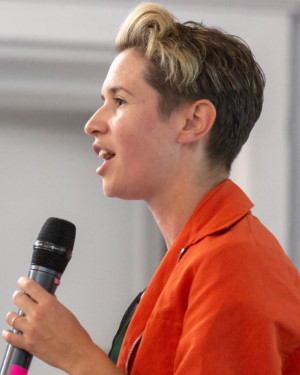

How to use the Good Services Scale to measure your service’s user-centredness
Author: Lou Downe;
Reading Time: 4 minutes
We've made this resource open. You are free to copy and adapt it. Read the terms.
If you would like more help with your digital challenge, book a free session with DigiCymru.
Editor’s intro: Last month we shared seven insights from GOV.UK’s former Design Director, Lou Downe. Today we are publishing in full their introduction to the Good Services Scale. This is relevant for charities because it’s the first attempt we’ve seen to create a scale based on what users need from a service, rather than what organisations think it should do.
Lou’s scale could be applied to any type of service, but we think it works best for digital services, or services that involve a lot of digital interaction.
Here’s Lou’s post introducing the scale.

I made a scale to measure the quality of services using the 15 principles of Good Service design. Here’s why.
When I wrote Good Services I made a pledge – to write something useful, and above all simple.
I deliberately didn’t include any kind of matrix, ‘canvas’ or score into the book because hell is other people’s diagrams, and I wanted to see how people would make use of the 15 Principles of Good Service Design before making it into any kind of ‘thing’ from it.
The book is now on its 3rd reprint and people are using the principles in all sorts of incredible ways – as a self assessment tool, user research discussion guide and even a way of prioritising change across an organisation.
There are many, *many* methods of measuring service quality out there – from NPS to SERVQUAL – but the problem most of them face is that they are either too complex to have an impact (and what’s the point of measuring something if you’re not going to do anything about it?!) or they measure entirely the wrong thing; at best not telling us what we need to know, and at worst incentivising behaviours that make our services worse.
What gets measured gets done
I’ve seen so many organisations head over a cliff chasing NPS ratings with gimmick after gimmick, ignoring the lack of accessibility in their service or the basic sign up processes riddled with dead ends.
If you measure recommendations you’ll do absolutely anything to get them. Measure cost and you’ll do anything to make your service cheaper. But measure whether your service is good for users? Then, maybe we stand a chance of motivating ourselves towards a better service.
That’s why I decided to make a Good Services Scale.
The Good Services Scale won’t give you a pat on the back for being the best, or ‘achieving excellence’ – only your users can tell you that.
In fact, the top of the scale is the bare minimum you can do to enable your users to achieve what they set out to do: using a functional service.
The Good Services Scale
There’s no complex 5 circled-spider-web to negotiate £1000s to pay in order to learn how to use it. It’s just a spreadsheet that helps you score your service on a scale from 0-4 for each of the 15 principles of good service design.
It’s available for free as a google sheet, spreadsheet, printable PDF (we’ll be heading back into offices sometime right?!) and a Miro template.
Use it to
- Self-assess the quality of your service, either on your own or with your team
- Structure your research with users and understand how your service is performing with different groups
- Benchmark your service and track how it improves over time
- Prioritise where to invest in service improvement by understanding which services need the most improvement
But most importantly; take it and make it yours. Adapt it, translate it, make it into a poster, do whatever you need to to make it work. And if you have thoughts on how to make it better, DM me on twitter.
I’d love to hear your stories of how you’ve used it, so please share those too.
Enjoy!
Commissioned by Catalyst
